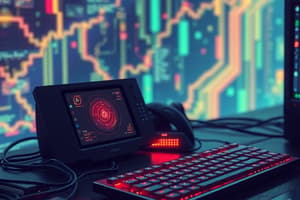Podcast
Questions and Answers
What is the primary function of a Card Reader?
What is the primary function of a Card Reader?
- To erase data from a card
- To write data onto a card
- To read data from a card (correct)
- To store digital data
What type of card is commonly used with a Card Reader?
What type of card is commonly used with a Card Reader?
- Punch card
- Magnetic card (correct)
- Optical card
- Credit card
What is the purpose of an OMR (Optical Mark Reader) device?
What is the purpose of an OMR (Optical Mark Reader) device?
- To mark optical cards
- To read optical marks (correct)
- To read digital data
- To write data onto a card
What is the typical use of a Card Reader in a computer?
What is the typical use of a Card Reader in a computer?
What is the characteristic of a punch card?
What is the characteristic of a punch card?
What is the purpose of a magnetic strip on a card?
What is the purpose of a magnetic strip on a card?
What is the difference between a Card Reader and an OMR device?
What is the difference between a Card Reader and an OMR device?
What is the common application of an OMR device?
What is the common application of an OMR device?
What is the result of using an OMR device in an objective-type exam?
What is the result of using an OMR device in an objective-type exam?
What is the advantage of using a Card Reader?
What is the advantage of using a Card Reader?
Flashcards are hidden until you start studying
Study Notes
Here are the study notes:
Input Devices
- Keyboard: an input device that allows users to type data into the computer
- Mouse: a pointing device that allows users to interact with the computer graphically
- Scanner: an input device that converts paper documents or images into digital data
- Barcode Reader: an input device that reads barcode data and transmits it to the computer
- Optical Mark Reader (OMR): an input device that reads marked data from forms and transmits it to the computer
Storage Devices
- Hard Disk: a non-volatile storage device that stores data permanently
- Floppy Disk: a portable storage device that stores data temporarily
- Compact Disk (CD): an optical storage device that stores data permanently
- Flash Drive: a portable storage device that stores data temporarily
Output Devices
- Monitor: an output device that displays text and images
- Printer: an output device that prints text and images on paper
- Speaker: an output device that produces sound
Computer System
- CPU (Central Processing Unit): the brain of the computer that executes instructions
- Motherboard: the main circuit board of the computer that connects all hardware components
- Power Supply: a component that provides power to the computer
- RAM (Random Access Memory): a volatile memory that stores data temporarily while the computer is running
Input/Output Operations
- Data Entry: the process of entering data into the computer using input devices
- Data Processing: the process of executing instructions by the CPU
- Data Storage: the process of storing data in storage devices
- Data Retrieval: the process of accessing stored data
Computer Peripherals
- Card Reader: a device that reads data from cards (e.g., credit cards)
- Magnetic Stripe Reader: a device that reads data from magnetic stripes on cards
- OMR (Optical Mark Reader): a device that reads marked data from forms
Let me know if you need any further assistance!
Studying That Suits You
Use AI to generate personalized quizzes and flashcards to suit your learning preferences.




